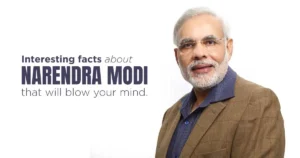Top 10 facts About Narendra Modi

Many people search “Top 10 facts About Narendra Modi” But they can not get particular information on Top 10 facts About Narendra Modi same keyword .
But you can easily get all information on your keyword “Top 10 facts About Narendra Modi”
Modi’s Childhood and Background Revealed
The 14th Prime Minister of India, Narendra Damodardas Modi, is a character whose rise from humble beginnings to the highest levels of power is both intriguing and inspiring.
Childhood in Vadnagar:
Modi’s boyhood was distinguished by simplicity, as he was born on September 17, 1950, in Vadnagar, a tiny village in Gujarat. He was the third of six children from a low-income household. Damodardas, his father, owned a tea stall near the Vadnagar railway station, while Hiraben handled the home.
Early Years and a Passion for Learning:
Narendra, as a child, was recognized for his curiosity and love of learning. Despite their meager financial resources, his parents were ardent supporters of his studies. During his school days, he demonstrated early signs of leadership by actively participating in debates and plays.
Life as a Nomad:
In search of spiritual enlightenment, a young Modi became a traveler, spending time in the Himalayas. He traveled widely, visiting ashrams and investigating many aspects of Indian spirituality.
Entering Politics:
Modi’s foray into politics was slow but determined. During his early years, he joined the Rashtriya Swayamsevak Sangh (RSS), a nationalist group, and was immediately immersed in organizational activities. His determination and organizational skills aided him in his ascension through the ranks, eventually leading to his affiliation with the Bharatiya Janata Party (BJP).
Ascend the Food Chain:
Modi’s political rise has been defined by his remarkable leadership and administrative ability. From 2001 to 2014, he served as Gujarat’s Chief Minister, earning both praise and condemnation. Gujarat saw tremendous economic expansion, infrastructure development, and novel governance methods throughout this time period. However, it was overshadowed by the communal violence of 2002, which is still a source of conflict and debate.
The Prime Ministerial Path:
In 2014, riding the wave of prosperity and change, Narendra Modi led the BJP to a historic win in general elections and became India’s Prime Minister. Several policy measures, like the ‘Make in India’ campaign, the Swachh Bharat Abhiyan (Clean India Mission), and demonetization, have elicited varying reactions from the public and professionals alike.
Modi’s Childhood and Background Revealed is the first heading in Top 10 facts About Narendra Modi
Narendra Modi’s Political Journey to Power
Narendra Modi, India’s 14th Prime Minister, is a man whose rise from humble beginnings to the highest levels of political power has been nothing short of remarkable.
Early Life and Political Career
Modi was born on September 17, 1950, in Vadnagar, a small hamlet in Gujarat, to poor parents and an unquenchable passion for study. He assisted his father in selling tea at a train station and spent his formative years engaged in politics and philosophy.
Modi’s political career began with his membership with the Hindu nationalist movement Rashtriya Swayamsevak Sangh (RSS). His RSS grassroots activity led to his affiliation with the Bharatiya Janata Party (BJP).
Gujarat Chief Minister: A Watershed Moment
When Modi became Chief Minister of Gujarat in 2001, his political career took a fundamental turn. During his stay in this role, he received both praise and criticism. The state had fast growth in infrastructure, industry, and economic growth, giving him the title of “development-oriented leader.”
His presidency, however, was overshadowed by the horrific Gujarat riots of 2002, which drew great scrutiny and debate. The handling of the riots polarized opinion about Modi, with supporters celebrating his leadership and critics raising significant concerns about human rights violations.
Victory and Prime Ministerial Aspirations
Modi’s ambition to become the country’s leader got greater with time. His aggressive leadership style and promise of economic progress drew a sizable number of Indian voters. Modi led the BJP to an extraordinary win in the 2014 general elections, securing a commanding majority and becoming India’s Prime Minister.
Achievements and Challenges of Prime Ministerial Tenure
Modi’s presidency has been marked by a number of significant initiatives and reforms. His government implemented ambitious programs such as the Swachh Bharat Abhiyan (Clean India Mission), Make in India, and the Goods and Services Tax (GST).
Prime Ministerial Tenure: Narendra Modi’s Revolutionary Era
Narendra Modi’s election as India’s Prime Minister in 2014 signaled the beginning of a revolutionary period in the country’s history. Modi has guided the country through a slew of policies, reforms, and initiatives, leaving an indelible impact on India’s socioeconomic environment. Let us look at some of his most notable accomplishments and highlights:
Initiatives for Economic Reform and Development
The government launched several ambitious economic changes under Modi’s leadership to boost India’s growth trajectory. The Goods and Services Tax (GST) was implemented in 2017 with the goal of simplifying the complicated tax structure and unifying the Indian market, hence boosting economic integration.
Schemes for Financial Inclusion and Welfare
During Modi’s reign, many welfare packages targeted at inclusive growth were implemented. The Jan Dhan Yojana aims to provide banking access to the unbanked, allowing millions to gain financial inclusion.
Environmental Initiatives and the Swachh Bharat Abhiyan
The Swachh Bharat Abhiyan (Clean India Mission) has evolved as one of the world’s most visible cleanliness efforts.
Modi has stressed environmental sustainability by promoting renewable energy and India’s commitment to combatting climate change through projects such as the International Solar Alliance (ISA).
COVID-19 Vaccination and Response Drive
During the COVID-19 epidemic, Modi’s government undertook a large vaccination campaign with the goal of immunizing millions of Indians against the virus. The ‘Aatmanirbhar Bharat’ (Self-Reliant India) initiative was launched to increase domestic output and lessen reliance.
Narendra Modi’s Political Journey to Power is the first heading in Top 10 facts About Narendra Modi